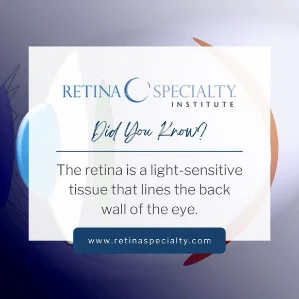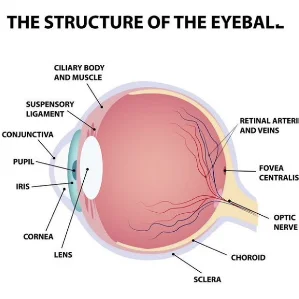At Retina Specialty Institute, our focus is on the diagnosis and treatment of retinal diseases and the preservation of patients’ eye health. One especially prevalent retinal condition we treat is macular degeneration. Prompt diagnosis and treatment of age-related macular degeneration can help our patients in Florida, Alabama, Mississippi, and throughout the Gulf Coast, safeguard the health of their eyes and their vision.
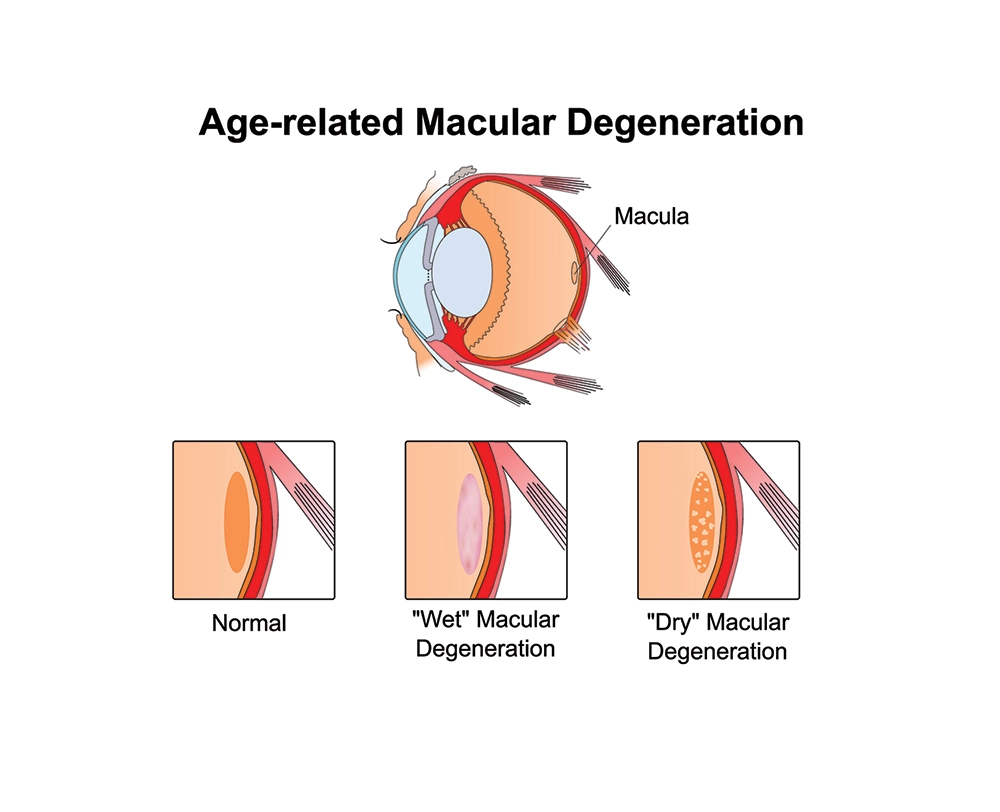
What is Macular Degeneration?
Age-related macular degeneration (AMD) is an eye disease that affects the macula, which is part of the retina. The retina is a layer of cells at the back of the eye that works with the brain to convert light into the images we see. The macula is at the center of the retina, and this is where images directly in front of us (central vision) are processed. This can impact activities of daily living including reading and driving. Age-related macular degeneration causes a
Trusted Source
Retina
Cleveland Clinic
Go to Source
gradual decrease in central vision
: usually peripheral vision is not affected.
Types of AMD
AMD is the leading cause of legal blindness in the United States in patients over the age of 60. The incidence of AMD increases with age. There are two types of age-related macular degeneration: dry (non-neovascular or atrophic) and wet (neovascular or exudative).
Dry Macular Degeneration
Dry macular degeneration is the most common form of this condition, affecting up to 90% of patients. The dry form of macular degeneration is caused by protein deposits called drusen forming under the macula, which eventually cause the macula to dry and thin. Vision loss from dry AMD is gradual and rarely total. In rare cases, dry age-related macular degeneration can progress to wet age-related macular degeneration. Advanced cases of dry age-related macular degeneration can lead to atrophy and additional loss of central vision.
Wet Macular Degeneration
Wet AMD is the presence of abnormal blood vessels under the macula that leak fluid or blood. This leakage results in distorted or blurred vision. Vision loss may be rapid or severe.
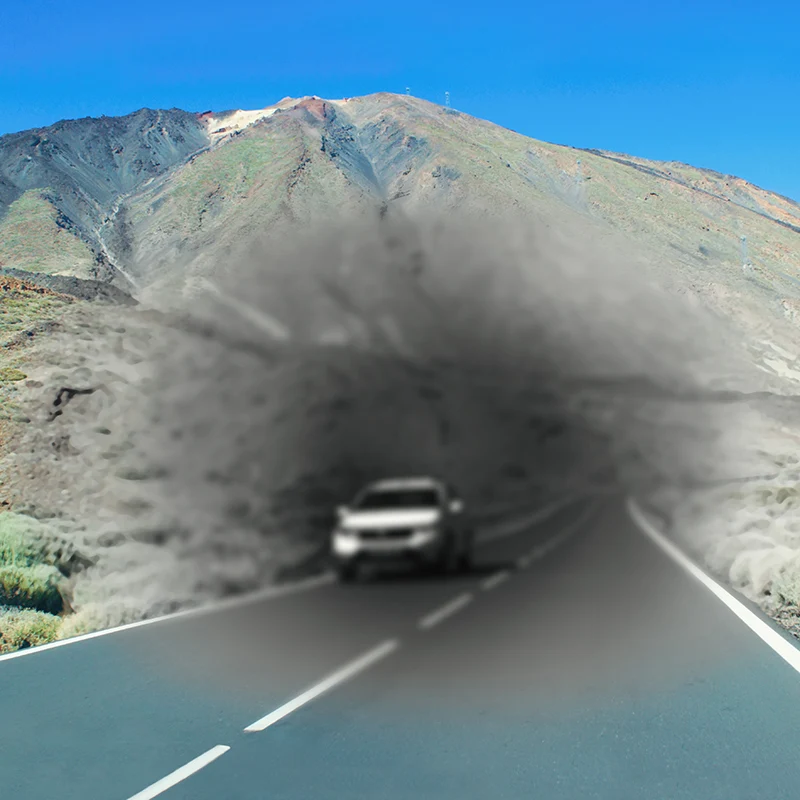
Symptoms of Macular Degeneration
Patients with early AMD may not notice any symptoms or vision problems. As the dry macular degeneration progresses, patients may encounter gradual changes to their vision, such as:
- Dark or blind spots in the central vision
- Vision that is distorted
- Difficulty seeing color
- Difficulty distinguishing fine details
- Vision that seems dim, especially when reading
In patients whose AMD has progressed to the wet form, straight lines may appear wavy or crooked. These patients may also experience growing blind spots, and vision loss can occur very rapidly, even over the course of days.

Diagnosis of Macular Degeneration
There are currently treatments available to slow progression and maintain vision. This is one reason it is vitally important to undergo regular eye exams: by identifying signs of macular degeneration early, your retina specialist can render prompt treatment and slow or prevent vision loss.
Age-related macular degeneration is diagnosed by your retina specialist during a dilated eye examination. For a definitive diagnosis, any or all of the following tests must be conducted:
- Visual acuity test
- Physical examination of the dilated eye
- Amsler grid test (to test central vision)
-
Trusted Source How is AMD Diagnosed and Treated? American Academy of Ophthalmology Go to Source Optical coherence tomography (OCT)
- Fluorescein angiography (dye is used to highlight the blood vessels in the eye)
- Fundus photography
- Fundus autofluorescence
Stages of Macular Degeneration
The progression of AMD is broken into three stages, classified by the patient’s symptoms and the signs an eye doctor detects.
Early Stage Macular Degeneration
Patients with early stage AMD often don’t experience any vision loss or symptoms. This stage is diagnosed by the over-presence of medium-sized drusen (protein deposits) under the retina.
Intermediate Stage Macular Degeneration
In patients with intermediate stage AMD, large drusen and changes in retinal pigment can be observed by an ophthalmologist. At this stage, most patients don’t experience significant vision loss, but may experience small gaps in their vision or minor vision changes.
Late Stage Macular Degeneration
When AMD has progressed to a late stage, damage to the retina has caused significant and severe vision loss. Patients may notice a distortion in vision, straight lines begin to look wavy, or a loss of central vision, when they have late stage age-related macular degeneration.
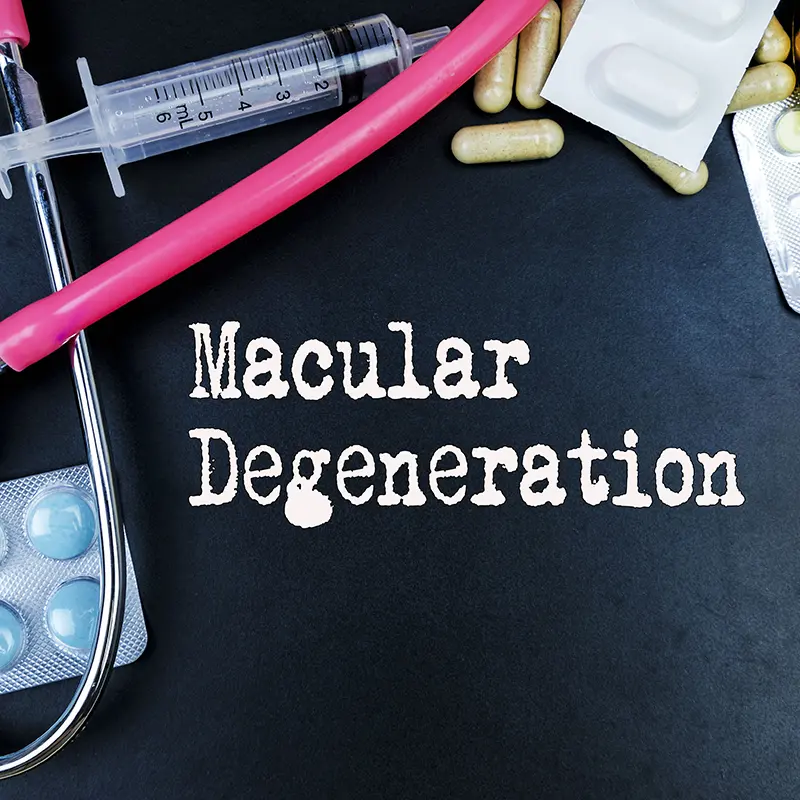
Treatment for Macular Degeneration
Age-related macular degeneration treatment is aimed to slow the progression and preserve a patient’s vision. Treatment depends on the types and stage of AMD as well as the severity of the patient’s condition.
For patients in intermediate stage macular degeneration, nutritional supplements known as AREDS or AREDS2 may stop the condition from progressing to late stage AMD.
According to the National Eye Institute, further vision loss in patients with wet AMD may be treated by: Ocular injections of anti-VEGF (vascular endothelial growth factor) medications.
Frequently Asked Questions About AMD
What are the risk factors for macular degeneration?
Age is the primary risk factor for macular degeneration, with
Trusted Source
Age-Related Macular Degeneration: Facts & Figures
BrightFocus Foundation
Go to Source
more than 30% of adults over the age of 75
receiving a diagnosis of advanced or intermediate age-related macular degeneration. In addition to age, certain genetic and environmental factors can increase the risk of developing AMD. Females are also more likely to develop macular degeneration, as are people with light eye color or skin.
Additional factors that may increase the risk of AMD include:
- Family history of macular degeneration
- Smoking
- Obesity
- A high fat diet
- High cholesterol
- High blood pressure
- Lack of exercise
- Prolonged sun exposure
- Certain medications
Can I prevent macular degeneration?
Macular degeneration can’t be prevented, but there are steps you can take to minimize your risk:
- Get plenty of exercise
- Eat a diet rich in Omega-3 fatty acids
- Get regular eye examinations
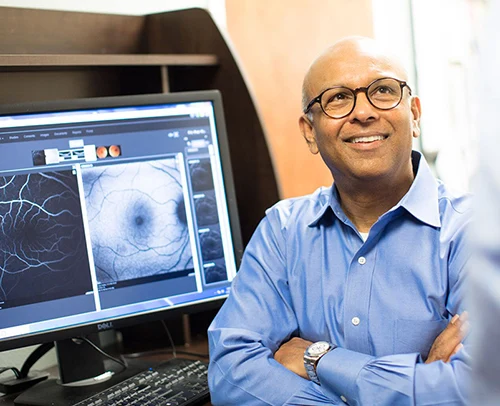
Contact Retina Specialty Institute
Regular eye exams are essential to the early diagnosis and treatment of age-related macular degeneration. To schedule an eye exam with an experienced ophthalmologist, or if you or your loved one has symptoms of age-related macular degeneration or have been diagnosed with AMD, please contact the retina experts at Retina Specialty Institute.
1 Cleveland Clinic. Retina. Available: https://my.clevelandclinic.org/health/body/22694-retina-eye#:~:text=The%20retina%20is%20made%20of,field%20(your%20peripheral%20vision). Accessed July 28, 2022.
2 American Academy of Ophthalmology. How is AMD Diagnosed and Treated? Available: https://www.aao.org/eye-health/diseases/amd-treatment. Accessed July 28, 2022.
3 BrightFocus Foundation. Age-Related Macular Degeneration: Facts & Figures. Available: https://www.brightfocus.org/macular/. Accessed March 18, 2025.
The doctors at Retina Specialty Institute have either authored or reviewed and approved this content.
Page Updated:



